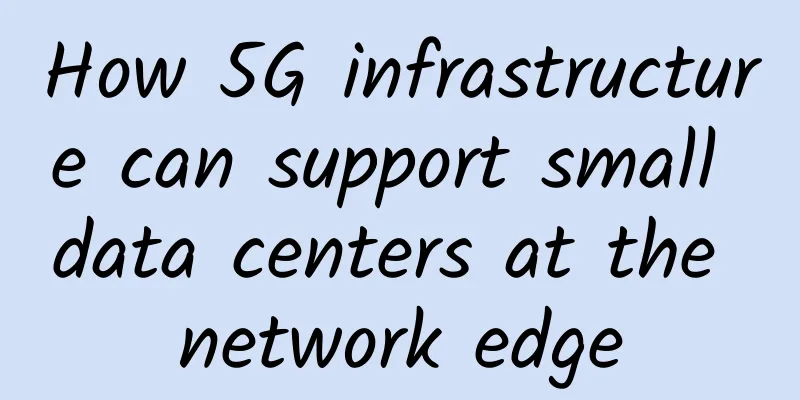How 5G infrastructure can support small data centers at the network edge

|
【51CTO.com Quick Translation】5G technology is used to support innovative applications and has stringent performance requirements in terms of speed, capacity, latency, reliability, etc. The large number of devices connected to the 5G network will generate huge data traffic. According to the forecast of research organization IDC, by 2025, the data traffic of global Internet of Things (IoT) devices will reach 90ZB. But not all data needs to be stored and processed in hyperscale data centers. In fact, most information will eventually be processed at the edge of the network. Therefore, the distance data must be transmitted on the network between user devices and hosting/processing infrastructure must be minimized. This helps reduce average latency to around 10 milliseconds, even below the 1 millisecond specified by the GSM Alliance in its 5G implementation standards. Having localized storage and processing resources means that information can be filtered, analyzed, and fed back more quickly, rather than having to travel back and forth through a series of switches, routers, base stations, points of presence, and telecommunications backbones to distant data center facilities, which can have a detrimental impact on network performance. Therefore, widespread adoption of 5G heralds the arrival of more small data centers that are closer to where the data is actually created, such as micro data centers or pod data centers, as well as hosting facilities embedded in telecommunications transmission equipment (including base stations, antenna towers, micro sites, access hubs, etc.) and even the endpoints themselves (including computers, smartphones and IoT devices). The topology depends on the application The fundamental shift in strategy and approach, along with the expected flood of data, will inevitably drive changes in the way telecom companies and multinational corporations provide network connectivity. 5G is designed as a service-driven architecture, so in most cases the exact topology for connecting communications equipment to the data center may depend on the application itself. For enhanced mobile broadband networks (i.e., high-speed mobile internet connections for users’ smartphones), this will mean a mix of 5G, 4G, and WiFi base stations built into a radio access network (RAN) that aggregates information from user devices before sending it to local data centers, where much of the information is cached (e.g., video content). The base stations transmit data to these local (or edge) facilities via wired wide area network (WAN) switches (or wireless mesh in some cases), and the local data centers are then connected to centralized hubs via edge, access points, and core telecom backbones. Similar topologies can be applied to massive machine type communication (mMTC) workloads, but also to ultra-reliable low latency communication (URLLC) use cases centered around Internet of Things (IoT) connectivity, such as applications in industry sectors such as smart grids, autonomous vehicles, remote surgery, intelligent transportation systems, etc. A local data center may not be needed here, as initial filtering, processing, and analysis can be done at the base station itself before a subset of the data is transmitted to a regional hosting facility. RAN relies on densely packed antennas to transmit data 5G RAN consists of various components, including Small Cells, transmission poles, transmission towers, base stations, and even home hubs, which aggregate residential traffic before transmitting it to the nearest base station. Small Cells, which range from ten meters to several hundred meters, are essential for providing high-bandwidth millimeter wave networks required for eMBB connections. Because the frequency range used in millimeter waves in the 28GHz to 40GHz band is very short, more antennas are required to provide continuous connections, which means that densely packed clusters will be available at any time to serve a large number of users. Elsewhere, 5G macro base stations will use multiple-input multiple-output (MIMO) antennas to send and receive large amounts of data simultaneously, and higher density massive multiple-input multiple-output (MIMO) antennas are required in areas with severe information congestion such as cities and transportation hubs. In most cases, 5G RAN will transmit data to local servers that aggregate user traffic into the core telecom network via some form of wired fiber WAN connection, but in some cases, ultra-high capacity 5G trunks that provide up to 10Gbps of wireless bandwidth will be used to backhaul RAN traffic. If network sharing with 4G infrastructure is required or implemented, local servers will also aggregate data from 4G macro base stations and WiFi access points that provide coverage (for example in city centers). Core Network Changes The RAN isn’t the only place where fundamental changes are being made to network configurations to better support edge-oriented 5G architectures. Non-radio 5G segments that connect devices to data centers are also being transformed, including fronthaul and backhaul nodes that aggregate traffic, the core network, the mobile edge, and the access network. Telecom companies and multinational corporations have gradually introduced software-defined networking (SDN) and network function virtualization (NFV) technologies into their architectures over the past few years, with the main purpose of reducing costs, speeding up resource provisioning and simplifying network management, while supporting higher computability and collaboration between different telecommunications platforms. Key changes to the core network include redesigned signaling mechanisms and distributed servers, which again help shorten the transmission path between devices and data centers to reduce latency and improve application performance. So-called "cloud native" networks designed specifically to support public cloud, private cloud and hybrid cloud workloads hosted in hyperscale data centers are also being implemented, with the main purpose of increasing the speed of software distribution and upgrades and speeding up automatic workload provisioning. Communications standards body 3GPP has also standardized 5G core network functions that will be based on cloud native and containers, supported by new security frameworks and quality of service (QoS) models for infrastructure (IaaS), platform (PaaS), software (SaaS) and other "as a service" applications hosted in service provider data centers. The architecture is designed to quickly scale bandwidth on demand to support those cloud computing services, while being flexible enough to support new use cases and go-to-market strategies through dynamic provisioning and configuration capabilities. It is designed to support network slicing, which can divide a single network connection into multiple different virtual connections and assign them to different categories of 5G devices, applications and data sets, for example, the performance indicators (speed, capacity and reliability) of each device, application and data set are managed by specific service level agreements (SLAs). There is no one-size-fits-all solution Research firm Gartner predicts that by 2025, edge computing facilities will process 75% of the data generated by enterprises. However, enterprise workloads will still only account for a small part of the total data, which will exceed 175ZB by 2025, compared with 33ZB in 2019. Not only that, almost half (49%) of the data will still be stored in public cloud environments, usually in hyperscale data center facilities, although smartphones with large amounts of local flash storage capabilities (for example, some smartphones have storage capacity of up to 256GB), the amount of data stored in core data centers will be more than twice the amount of data stored in endpoints. In summary, 5G networks will bring significant changes to the way data centers operate and connect, but the number of connected 5G devices and the vast amounts of information they create means that multiple data and application hosting methods will coexist for a long time. Original title: Data centers on the network Edge, author: Martin Courtney [Translated by 51CTO. Please indicate the original translator and source as 51CTO.com when reprinting on partner sites] |
<<: Let's talk about the DHCP protocol
>>: New infrastructure becomes the biggest driving force for China's data center industry in 2020
Recommend
VMISS newly launched Hong Kong international line VPS with 30% discount and annual payment starting from 10 US dollars, and you can choose US CN2 GIA/AS9929/CMIN2, etc.
A few days ago, we shared the information about D...
Network Basics: TCP/IP protocol responsibilities and three common models
1. The main responsibilities of TCP/IP protocol ●...
What is OSI model?
Today I tweeted some thoughts about how the OSI m...
Σco Time | The "new" foundation of digital economy, Huawei and Xinghai IoT create a sustainable growth smart park
[51CTO.com original article] In the context of po...
H3C wins bid for Qingdao Metro to boost the development of Qingdao's urban rail transit
Recently, New H3C Group, a subsidiary of Tsinghua...
Learn RTMP and RTSP streaming protocols in seconds
RTMP and RTSP are two common streaming protocols....
5G Internet: A High-Speed Alternative to Cable?
If you want fiber-like speeds or high-speed inter...
The most beautiful ecosystem is on the road. Huawei China ICT Ecosystem Tour 2018 demonstrates the "power of walking"
[51CTO.com original article] At the end of May, t...
Israel enters the 5G era: commercial licenses issued, three major operators quickly launch services
Beijing time, October 6 evening news (Jiang Junmu...
Huawei Intelligent Computing releases FusionServer Pro intelligent server to help data centers evolve towards intelligence
[51CTO.com original article] Recently, Huawei'...
Server-Speaks-First is a bit of a bummer, protocol detection and opaque ports in Linkerd 2.10
[[416375]] This article is reprinted from the WeC...
Comprehensive Guide to Fiber Optic Boxes
Fiber cassettes are an essential part of a fiber ...
China Mobile has built more than 410,000 5G base stations
On April 25, China Mobile General Manager Dong Xi...
Cisco's Scott Harrell: A new era of networking has arrived. Cisco empowers enterprises to innovate and transform
[51CTO.com original article] On the eve of the 20...
In the DT era, what is the trend of data center cabling?
As enterprises realize that structured cabling is...









